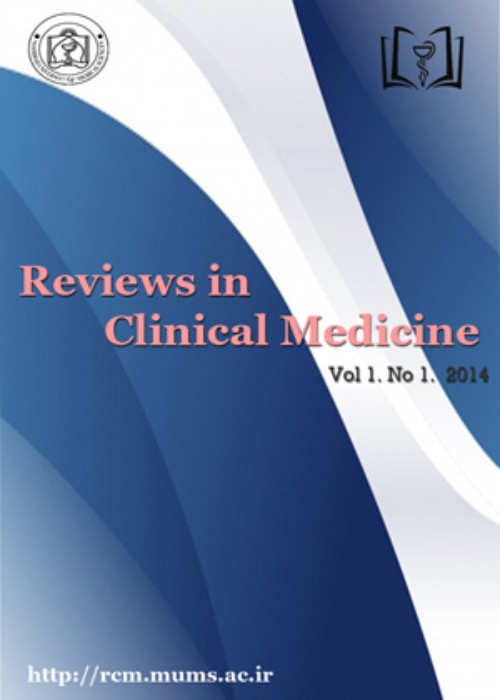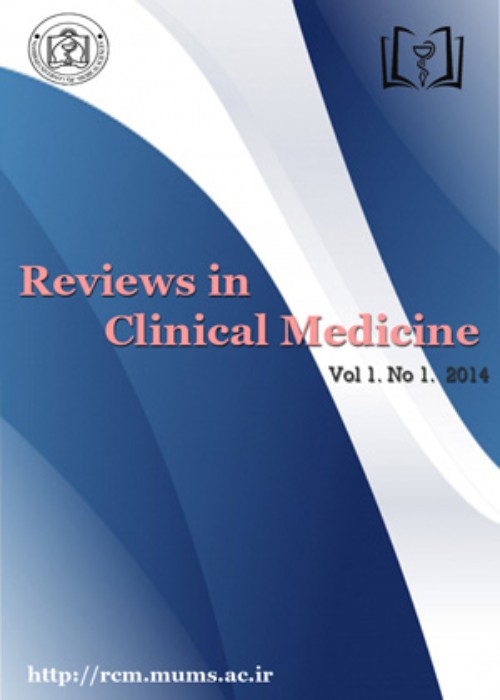فهرست مطالب

Reviews in Clinical Medicine
Volume:10 Issue: 4, Autumn 2023
- تاریخ انتشار: 1402/09/10
- تعداد عناوین: 8
-
Pages 1-10Introduction
The aim of this study was to identify methods for detecting composition and fraud in meat foods.
MethodsAn extensive literature review was conducted in 2022 using the electronic databases: Web of Science, Scopus, SID, and PubMed. The search was limited to articles published in English from 1970 to 2022. Search terms used were “fraud”, “meat products”, “Iran,” “ authentleication,” “detection,” and “adulteration”.
ResultsGenetic-based molecular tests (PCR) and less use of histological and chemical tests were used to detect fraud and its type in meat products. PCR was used in 30 cases to identify the type of cheating in meat products such as sausages. Histological methods were used in 19 cases to detect type of violation.
ConclusionMolecular methods for detecting food fraud are highly accurate; therefore, they have the highest detection rate.
Keywords: Fraud, Food, meat products, Adulteration -
Pages 11-17IntroductionThe breast cancer burden is still increasing, both in developing and developed countries. The present study was conducted to determine the survival rate of breast cancer based on tumor biological subtypes in patients referring to three referral oncology centers at Mashhad University of Medical Sciences, Mashhad, Iran.MethodsThe present population-based study was conducted at Imam Reza Hospital, Omid Hospital, and Reza Oncology Center, Mashhad University of Medical Sciences, Mashhad, Iran Demographic information, the status of biomarkers in immune-histochemical evaluation, clinical and pathological features of the tumor, type of therapy, recurrence, or death was recorded for each eligible patient.ResultsIn total, 247 patients were included in the study. The mean age of patients was 48.8 ± 1.3 years. The mean time of survival was 2.64±0.13 years. In detail, the survival rate from the first year to the fifth year was reported as 100%, 96%, 91%, 90%, and 89%, respectively. The survival rate of the luminal B subtype was higher than other subtypes but the difference was not significant (P=0.7). Only in terms of metastasis, there was a significant difference between the alive and dead patients (P=0.0001).ConclusionDespite no significant relationship between biological markers, the breast cancer subtype, and its survival rate, the overall survival rate of the patients decreased lightly through five years. However, further studies are required to indicate more accurate data about the breast cancer survival rate in our region.Keywords: Breast Cancer, Iran, Survival rate, Epidemiology
-
Pages 18-20Introduction
Between 50-75% of children and adolescents with systemic lupus erythematosus (SLE) experience kidney involvement within the first year of diagnosis. The gold standard for diagnosing renal involvement in SLE is a renal biopsy. It is uncommon for SLE to cause isolated tubular involvement without any glomerular disease.
Case PresentationWe report an adolescent girl with a known history of systemic lupus erythematosus who presented to the emergency department with progressively worsening weakness. The diagnosis revealed that she had distal renal tubular acidosis (RTA) without any glomerular disease. Her history of nephrocalcinosis and kidney stones on renal ultrasound is most consistent with distal renal tubular acidosis diagnosis.
ConclusionThis case highlights the importance of considering renal tubular acidosis in lupus patients who experience recurrent hypokalemic episodes. When a patient presents with a normal anion gap metabolic acidosis and hyperchloremia, without evidence of gastrointestinal HCO3 loss or absorption of exogenous acid, renal tubular acidosis (RTA) should be considered.
Keywords: Renal tubular acidosis, systemic lupus erythematosus, Tubular involvement, Nephrocalcinosis -
Pages 21-31Introduction
As a chronic autoimmune disease, Rheumatoid arthritis (RA) affects the joints. Studies have shown a complex and challenging link between cancer and RA. However, articles claim a significant relationship between cancer and treatment with DMARDs and biological DMARDs (e.g., Abatacept); however, the results are contradictory. Accordingly, this systematic review investigates the prevalence of cancer in RA patients taking Abatacept.
MethodsWe searched for articles published in four databases, namely Web of Science, Medline, PubMed, and Scopus up to September 29, 2023. The methodology followed recommendations from the Cochrane Handbook. During the search process, we selected articles using keywords such as “rheumatoid arthritis”, “malignancy”, and “cancer” with the Boolean operators “AND” and “OR”.”
ResultsA total of 12 studies were considered, the majority highlighted the effectiveness of Abatacept as an anti-RA medicine in the risk of cancer prevalence. Most of the patients investigated in the trials were female. Lung cancer was the greatest malignancy in those suffering from RA diseases. However, these investigations found no significant link between Abatacept use and cancer risk.
ConclusionThere is speculation regarding the potential use of rheumatoid arthritis drugs in treating RA and its potential association with cancer incidence. According to the findings presented in this review article, there was no statistically significant association between the utilization of Abatacept and the prevalence of cancer in patients who were administered Abatacept either as a standalone treatment or in combination with other anti-rheumatoid medications. However, it is advised that further clinical trials be conducted to thoroughly investigate this association.
Keywords: Abatacept, Antirheumatic Agents, Neoplasms, Rheumatic Diseases -
Pages 32-40Introduction
Epidermolysis bullosa (EB) represents a diverse set of disorders that affect the skin and mucous membranes. Ensuring proper nutrition for children and adolescents with Epidermolysis Bullosa is a vital aspect of their treatment plan. The objective of this study is to demonstrate how nutritional intervention in a specialized nutrition clinic can enhance their well-being.
Methods and material:
This longitudinal study was conducted over a 3-year period at Akbar Children Hospital, a tertiary facility affiliated with Mashhad University of Medical Sciences in Iran. The study included all patients diagnosed with EB based on clinical symptoms and genetic studies.
ResultsIn the present study, the median (25-75 IQR) age of the participants was 81.0 (36.0-156.0) months, and 19% of the participants were girls. The median (25-75 IQR) weight was 17.5 (10.8-24.5) kg, and the mean ± SD of height was 109.9 ± 31.1 cm. Among all types of malnutrition, there was only a significant association between gastrointestinal complications and BMI-for-age z-score (OR: 0.08, P-value=0.039) in the crude model. After adjustment, there was no significant association between gastrointestinal complications and malnutrition. The mean values of weight at the baseline, the first, and the second appointment of the study were 21.3, 21.2, and 24.8 kg, respectively. Moreover, the mean height at the baseline, the first, and the second appointment of the study were 109.4, 121.0, and 123.4 cm, respectively.
ConclusionRegular clinic visits and tailored nutritional interventions positively impact EB patients, emphasizing the importance of managing anemia and deficiencies for their well-being.
Keywords: Epidermolysis bullosa (EB), Nutritional support, Children, Adolescents -
Pages 41-49IntroductionEpidemiologic studies have shown a discrepancy between overweight and puberty processes. This cross-sectional study was aimed to clarify these associations in the Iranian girl population.MethodsA total of 1300 girls aged 11-15 years were randomly selected from Mashhad, in the northeast of Iran, using a multi-stage cluster sampling method. The demographic data were collected and weight, height, and waist circumference (WC) were measured, then Body Mass Index (BMI) and Waist-to-Hip ratio were calculated. Overweight and obesity were defined based on WHO reference data. Central obesity was defined as ≥90th percentile of WC. Linear regression an unconditional binary logistic regression were performed to investigate the association between sociodemographic parameters and age at menarche in months, puberty categories, and menarche age groups (<12 vs. ≥12 years) respectively.ResultsThe prevalence of overweight, obesity, and abdominal fat distribution were 11.5%, 10.3%, and 10.5% respectively. Menarche was experienced by 63% of subjects at the mean age of 12.24±0.98 years. Regression tests revealed that the odds of menarche occurrence at the age of 12 or more was significantly lower in girls with higher BMI (OR: 0.31, 95%CI: 0.22-0.43) than their leaner counterparts (P< 0.001).ConclusionThe findings suggest that being overweight or obese is a possible predictor of experiencing menarche at a younger age.Keywords: Adolescent, Iranian, Menarche, Obesity
-
Pages 50-57IntroductionMulti-organ iron load is prevalent crucial side effect in thalassemic patients due to repeated transfusions, and high intestinal iron absorption. MRI T2* has demonstrated its potency as a non-invasive technique for the imaging of hemosiderosis in thalassemia. We aim to investigate the iron load of adrenal glands and kidneys using MRI T2* in adult thalassemia patients and evaluate the serum ferritin correlation of with kidneys, heart, liver, and adrenal glands’ iron load.MethodsThirty-five thalassemia major (TM) and thalassemia intermediate (TI) patients (age range 18-50 years) from Zafar thalassemia Clinic, were recruited in this survey from September 2019 to October 2020. Magnetic Resonance Imaging (MRI) was used to map iron overload in several organs’ regions of interest (ROIs) using fast-gradient-echo multi echo T2*sequences protocol. T-test and chi-square analysis were done.ResultsNine (25.7%) patients had left Kidney T2* less than 36ms which could indicate abnormal renal iron load while this was 8 (22.9%) for the right kidney. In the left and right adrenal glands, these numbers were 31 (88.6%) and 29 (82.9%), respectively, below the normal threshold.ConclusionAdrenal gland and renal iron overloads were detected in MRI images of thalassemic patients. Correlation for serum ferritin levels and kidney and adrenal glands T2* was found weakly negative. Non-invasive monitoring of the internal organs’ hemosiderosis using MRI T2* was found to be beneficial for iron-chelating optimization and preventing irreversible tissue damage.Keywords: magnetic resonance imaging, Iron overload, Thalassemia, Kidney, Adrenal glands
-
Pages 58-62IntroductionZinc has a key role in reproductive physiology, immune modulation, growth, and development. To determine the effect of zinc supplements on the anthropometry of healthy 6-yearold children.MethodsIn this double-blind placebo-controlled trial was carried out on 40 children 6-7 years old. The intervention group (n=20) received 20mg of oral zinc sulfate syrup and the control group (n=20) received a placebo daily in the same buttle and same test for 6 months duration of study. Serum zinc levels and anthropometric measurements (weight, height, head circumference, and arm circumference) were measured before and after intervention. Zinc deficiency was defined as serum zinc level < 9.9 μmol/l.ResultsSerum zinc level did not differ between the two groups (P=0.86). Zinc supplementation resulted in a significant increase in height (P= 0.008).ConclusionThis study showed that zinc supplements have a significant increase in the length of male 6-year-old children.Keywords: Children, Zinc, growth


